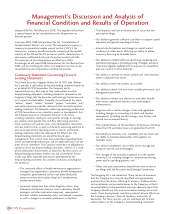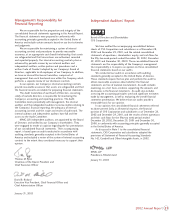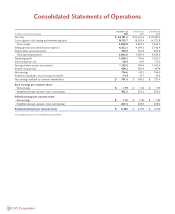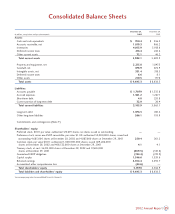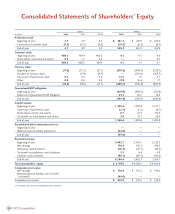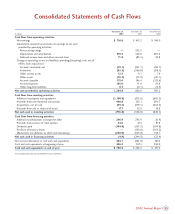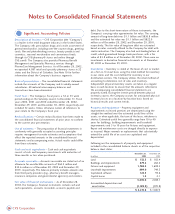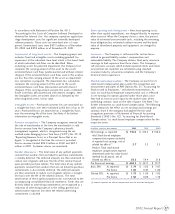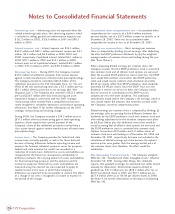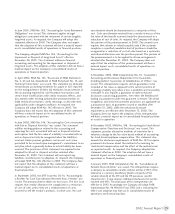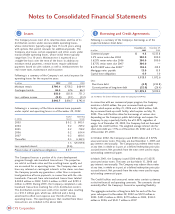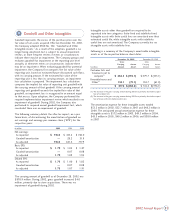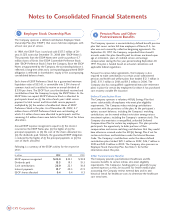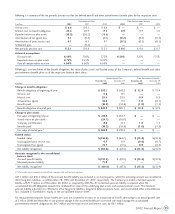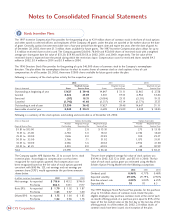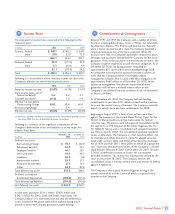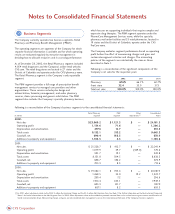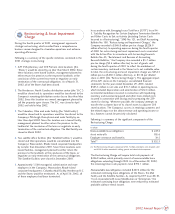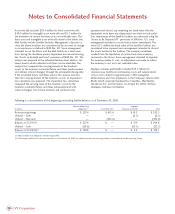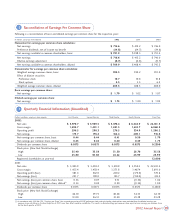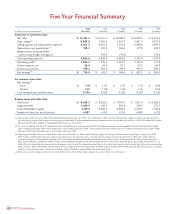CVS 2002 Annual Report Download - page 32
Download and view the complete annual report
Please find page 32 of the 2002 CVS annual report below. You can navigate through the pages in the report by either clicking on the pages listed below, or by using the keyword search tool below to find specific information within the annual report.
Borrowing and Credit Agreements
Following is a summary of the Company’s borrowings as of the
respective balance sheet dates:
In connection with our commercial paper program, the Company
maintains a $650 million, five-year unsecured back-up credit
facility, which expires on May 21, 2006 and a $650 million, 364-
day unsecured back-up credit facility, which expires on May 19,
2003. The credit facilities allow for borrowings at various rates
depending on the Company’s public debt ratings and require the
Company to pay a quarterly facility fee of 0.08%, regardless of
usage. As of December 28, 2002, the Company had not borrowed
against the credit facilities. The weighted average interest rate for
short-term debt was 1.9% as of December 28, 2002 and 2.1% as
of December 29, 2001.
In October 2002, the Company issued $300 million of 3.875%
unsecured senior notes. The notes are due November 1, 2007, and
pay interest semi-annually. The Company may redeem these notes
at any time, in whole or in part, at a defined redemption price plus
accrued interest. Net proceeds from the notes were used to repay
outstanding commercial paper.
In March 2001, the Company issued $300 million of 5.625%
unsecured senior notes. The notes are due March 15, 2006 and
pay interest semi-annually. The Company may redeem these notes
at any time, in whole or in part, at a defined redemption price plus
accrued interest. Net proceeds from the notes were used to repay
outstanding commercial paper.
The Credit Facilities and unsecured senior notes contain customary
restrictive financial and operating covenants. The covenants do not
materially affect the Company’s financial or operating flexibility.
The aggregate maturities of long-term debt for each of the five
years subsequent to December 28, 2002 are $32.0 million in
2003, $323.2 million in 2004, $27.9 million in 2005, $334.3
million in 2006, and $341.7 million in 2007.
Leases
The Company leases most of its retail locations and five of its
distribution centers under noncancelable operating leases,
whose initial terms typically range from 15 to 22 years, along
with options that permit renewals for additional periods. The
Company also leases certain equipment and other assets under
noncancelable operating leases, whose initial terms typically
range from 3 to 10 years. Minimum rent is expensed on a
straight-line basis over the term of the lease. In addition to
minimum rental payments, certain leases require additional
payments based on sales volume, as well as reimbursements for
real estate taxes, maintenance and insurance.
Following is a summary of the Company’s net rental expense for
operating leases for the respective years:
Following is a summary of the future minimum lease payments
under capital and operating leases as of December 28, 2002:
The Company finances a portion of its store development
program through sale-leaseback transactions. The properties
are sold at net book value and the resulting leases qualify and
are accounted for as operating leases. The Company does not
have any retained or contingent interests in the stores nor does
the Company provide any guarantees, other than a corporate
level guarantee of lease payments, in connection with the sale-
leasebacks. Proceeds from sale-leaseback transactions totaled
$448.8 million in 2002, $323.3 million in 2001 and $299.3
million in 2000. During 2001, the Company completed a sale-
leaseback transaction involving five of its distribution centers.
The distribution centers were sold at fair market value resulting
in a $35.5 million gain, which was deferred and is being
amortized to offset rent expense over the life of the new
operating leases. The operating leases that resulted from these
transactions are included in the above table.
Notes to Consolidated Financial Statements
Capital Operating
In millions Leases Leases
2003 $ 0.2 $ 805.1
2004 0.2 769.2
2005 0.2 718.2
2006 0.2 654.4
2007 0.2 600.5
Thereafter 0.5 6,162.4
1.5 $9,709.8
Less: imputed interest (0.6)
Present value of capital lease obligations $ 0.9
In millions 2002 2001 2000
Minimum rentals $ 790.4 $758.2 $684.9
Contingent rentals 65.6 67.6 66.3
856.0 825.8 751.2
Less: sublease income (9.3) (9.1) (9.2)
$846.7 $ 816.7 $742.0
December 28, December 29,
In millions 2002 2001
Commercial paper $4.8 $235.8
5.5% senior notes due 2004 300.0 300.0
5.625% senior notes due 2006 300.0 300.0
3.875% senior notes due 2007 300.0 —
8.52% ESOP notes due 2008(1) 19 4 . 4 219 . 9
Mortgage notes payable 13. 0 15 . 9
Capital lease obligations 0.9 1.0
1,113.1 1,072.6
Less:
Short-term debt (4.8) (235.8)
Current portion of long-term debt (32.0) (26.4)
$ 1,076.3 $810.4
(1) See Note 5 for further information about the Company’s ESOP Plan.
30 CVS Corporation
2 3


